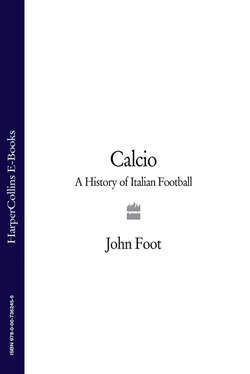Читать книгу Calcio: A History of Italian Football - John Foot - Страница 75
Disintegration
Оглавление‘Inside every fat man, they say, there is a thin man trying to get out. In the case of Maradona, it seems, there is an even fatter man trying to get in’
MARTIN AMIS19
The early part of the twenty-first century saw Maradona’s fortunes take another dip. Separated from his wife, he roamed around the world, staying for a time in Cuba, where he tried to break his drugs habit once again. His fortune, it appeared, was all gone. Maradona blamed his ex-agent, Guillermo Coppola. Others claimed that all of his entourage had wanted a piece of him. Grotesquely fat, he went along with a series of humiliating requests in Argentina, such as the opening of supermarkets. He took up a regular spot on the popular if squalid Italian TV football-argument show, Monday’s Trial, and had an enormous likeness of Che Guevara tattooed on his upper arm. From Cuba, he attacked George Bush and the ‘war on terrorism’. The ‘Cuban Cure’, however, did not seem to have done the trick.
In April 2004 Maradona was taken to hospital in Argentina with serious heart failure. He had played golf at night and then fallen asleep, and vomit had ended up in his lungs. Traces of cocaine – enough ‘to kill a man’ – were found in his blood. His heart, the doctors said, was only half-working. Diego was put on a respirator. The Italian press drew comparisons with the sad demise of 34-year-old cyclist Marco Pantani, who had been found dead in a Rimini hotel room only weeks earlier. Pantani was also a cocaine addict and, in the end, the drug had killed him. At the age of 43, Maradona was fighting for his life. Fans and well-wishers gathered outside the hospital whilst Argentinian TV showed his goals again and again. Diego was described as ‘a little less than a god’. In Naples, shopkeepers set up message boards with photos of Diego; fans left notes stuck on the wall: ‘we will never forget you’; ‘Diego forever’; ‘come back and help us dream’. A makeshift altar was assembled, with a scudetto sign, kitsch fake pillars, Napoli colours and a photo of a young, thinner Maradona. Fans touched the picture, crossed themselves, and prayed. Italian journalists wrote that it was ‘a miracle’ that Maradona was still alive and that he had ‘the heart of an eighty-year-old’. Maradona survived, but only just, and the headlong drive towards self-destruction of this footballing genius, the King of Naples, continued apace, watched over by a voracious media machine. Just when he seemed to be finished, however, Maradona recovered, for the umpteenth time. He had an operation to lose weight, visited Napoli for an emotional testimonial match for his friend Ciro Ferrara, and even returned to the world of football, taking over as vice-president of Boca Juniors in 2005. A post from which he resigned in 2006.
His reputation also improved. La Gazzetta dello Sport produced – with Gianni Minà – a 10-part DVD history dedicated to Maradona’s life and career. The success of this initiative showed how the hatred Diego inspired in the 1980s amongst many Italian fans had dissipated. In 2007 a feature film appeared called La mano di dio, directed by Marco Risi. But Maradona’s miraculous recovery was short-lived. In 2007 he was back in hospital in Argentina, and there were even rumours that he had died, and he was later admitted to a psychiatric clinic after being diagnosed as an alcoholic. Meanwhile, his son Diego Jr decided to take Diego Sr to court over non-payment of maintenance. The media would not have long to wait for the next twist in the Maradona saga.
